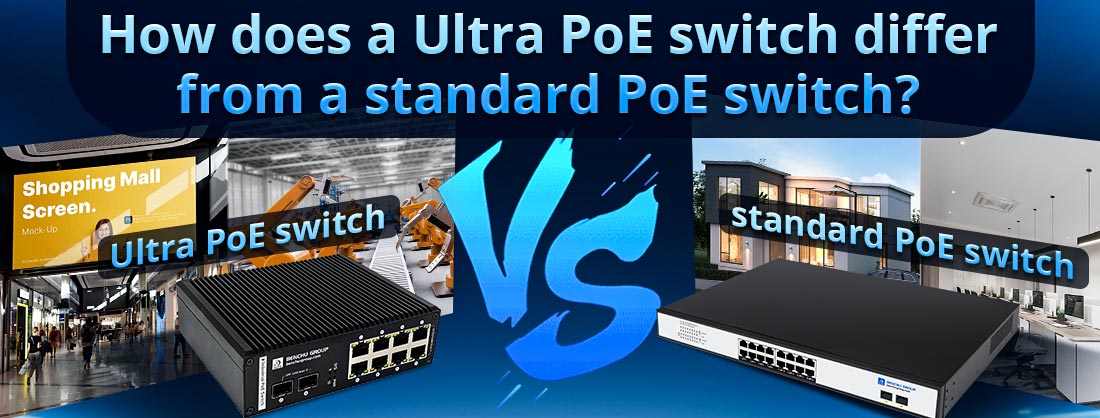
Коммутатор Ultra PoE и стандартный коммутатор PoE выполняют основную функцию передачи питания и данных через кабели Ethernet к подключенным сетевым устройствам, но они имеют явные различия в возможностях выходной мощности, диапазоне и применении. Вот подробный обзор того, чем отличаются эти два типа переключателей:
1. Выходная мощность
Стандартный коммутатор PoE:
--- Стандартный коммутатор PoE соответствует обычным стандартам PoE, таким как IEEE 802.3af (PoE), который обеспечивает мощность до 15,4 Вт на порт, IEEE 802.3at (PoE+) при 30 Вт на порт и IEEE 802.3bt (PoE++) с вариантами выходной мощности до 60 Вт (Тип 3) или 100 Вт (Тип 4) на порт.
--- Эти коммутаторы обеспечивают достаточное питание таких устройств, как базовые IP-камеры, телефоны VoIP и стандартные точки беспроводного доступа.
Ультра PoE-переключатель:
--- Ультра PoE-переключатель предназначен для обеспечения более высокой выходной мощности, чем стандартные ограничения PoE. Оно может превышать характеристики мощности, установленные стандартами PoE, PoE+ или даже PoE++. Функция «Ультра» включает в себя специализированную внутреннюю схему питания, которая может увеличить выходную мощность для поддержки мощных устройств.
--- Повышенная выходная мощность необходима для устройств с более высокими требованиями к энергии, таких как уличные PTZ-камеры (поворотно-наклонно-масштабируемые) с нагревателями, большие светодиодные дисплеи и промышленные точки беспроводного доступа.
2. Диапазон и дальность действия
Стандартный коммутатор PoE:
--- Обычно поддерживает передачу питания и данных на расстояние до 100 метров (328 футов) по кабелям Ethernet Cat5e или выше. Этого расстояния достаточно для большинства офисных или домашних сетей, где устройства расположены относительно близко к коммутатору.
--- За пределами этого 100-метрового предела уровень сигнала и выходная мощность ослабевают, что требует использования удлинителей или дополнительных переключателей для больших расстояний.
Ультра PoE-переключатель:
--- Часто имеет возможность расширить диапазон мощности и передачи данных за пределы стандартных 100 метров, иногда до 200-250 метров и более без дополнительного оборудования. Такая расширенная зона действия полезна в установках, где сетевые устройства расположены дальше от главного коммутатора, например, на открытом воздухе, в промышленных помещениях или в кампусах.
3. Применение и варианты использования
Стандартный коммутатор PoE:
--- Идеально подходит для обычных офисных, домашних и легких коммерческих приложений, где требования к электропитанию скромны. Примеры включают питание базовых IP-камер, телефонов VoIP и стандартных точек доступа, которые соответствуют типичному бюджету мощности стандартов PoE.
--- Лучше всего подходит для установок, где устройства находятся в пределах 100 метров от коммутатора.
Ультра PoE-переключатель:
--- Разработан для специализированных сред, требующих более высокой мощности и/или большего радиуса действия. Его обычно используют для:
--- Мощные камеры наружного наблюдения с такими функциями, как инфракрасные датчики и моторизованный зум.
--- Точки доступа промышленного уровня, для эффективной работы которых требуется более высокая мощность.
--- Цифровые вывески или дисплеи, которым требуется больше энергии, чем может обеспечить стандартный коммутатор PoE.
--- Удаленные установки, например, системы безопасности по периметру, где розетки могут быть недоступны.
4. Приоритет портов и управление питанием
Стандартный коммутатор PoE:
--- Обычно включает базовые возможности управления питанием, такие как определение приоритетов портов для распределения мощности в случае превышения общего бюджета мощности. Однако он соответствует ограничениям встроенного источника питания и стандартов PoE.
--- Некоторые управляемые стандартные коммутаторы PoE допускают ограниченную настройку распределения мощности между портами.
Ультра PoE-переключатель:
--- Часто оснащен расширенными функциями управления питанием для эффективного управления выходной мощностью более высокой мощности и обеспечения стабильного распределения мощности по всем портам. Это включает в себя улучшенную приоритезацию портов для эффективного распределения мощности в зависимости от потребностей устройства.
--- Эти коммутаторы могут поддерживать динамическое управление питанием, что означает, что они могут регулировать уровни мощности, подаваемые на отдельные порты, в зависимости от потребностей в реальном времени.
5. Стоимость и сложность
Стандартный коммутатор PoE:
--- Более экономичный и простой в установке и управлении. Они широко используются в типичных сетевых условиях, где требования к мощности и данным умеренные.
--- Легче настроить и использовать нетехническим пользователям без специальных знаний.
Ультра PoE-переключатель:
--- Как правило, дороже из-за расширенных возможностей мощности и дополнительных функций для Power Ultraing и расширенного радиуса действия.
--- Установка и управление могут потребовать дополнительных знаний или опыта, особенно для более сложных и крупномасштабных развертываний.
Сводка сравнения
| Особенность | Стандартный коммутатор PoE | Ультра PoE-переключатель |
| Выходная мощность на порт | До 15,4 Вт (PoE), 30 Вт (PoE+), 60/100 Вт (PoE++) | Превышает стандартные ограничения PoE; более высокая мощность на порт |
| Максимальное расстояние | Обычно до 100 метров. | Часто простирается за пределы 100 метров (до 200-250 м). |
| Вариант использования | Офис, дом, стандартные настройки сети | Промышленное, наружное, мощное развертывание на больших расстояниях |
| Управление питанием портов | Базовое или стандартное управление | Улучшенное управление питанием с возможностью Ultraing |
| Расходы | Ниже, доступнее | Выше, благодаря расширенным функциям и выходной мощности |
| Сложность установки | Проще | Более сложный, может потребоваться техническая экспертиза |
Заключение
Ультра PoE-переключатель это специализированный сетевой инструмент для приложений, где необходимы высокая мощность и возможность подключения на большие расстояния. Напротив, стандартный коммутатор PoE подходит для типичных сред, где достаточна умеренная мощность и стандартное расстояние. Выбор между двумя зависит от требований к питанию ваших устройств, места установки и бюджета.